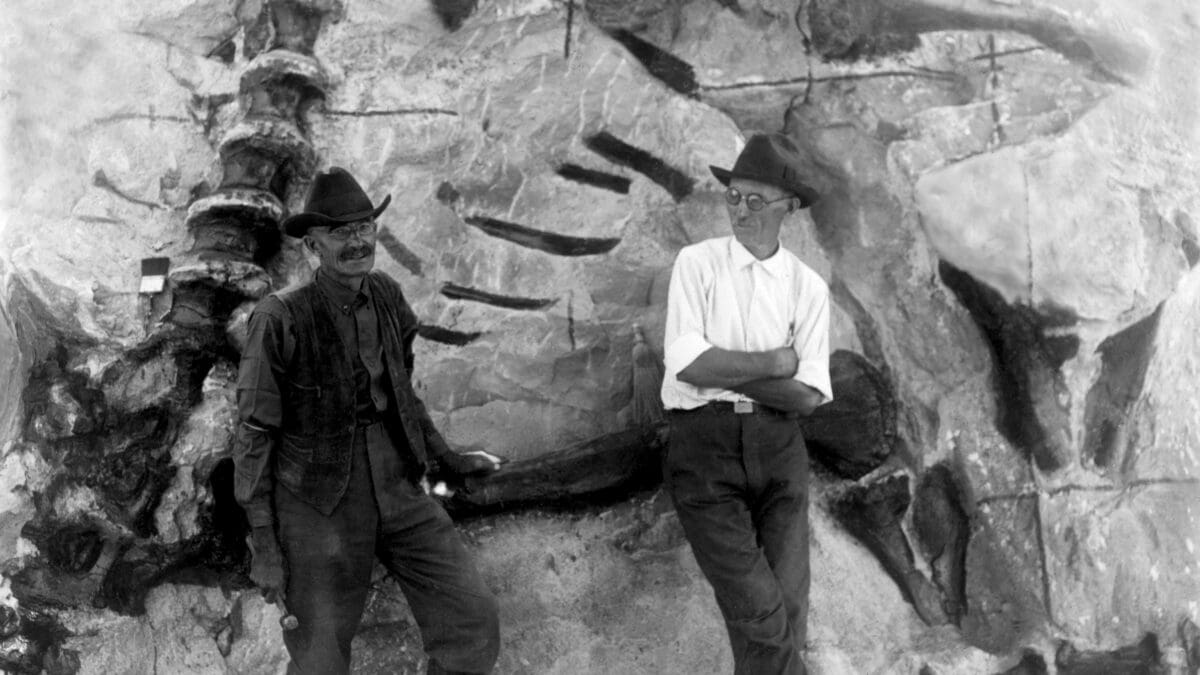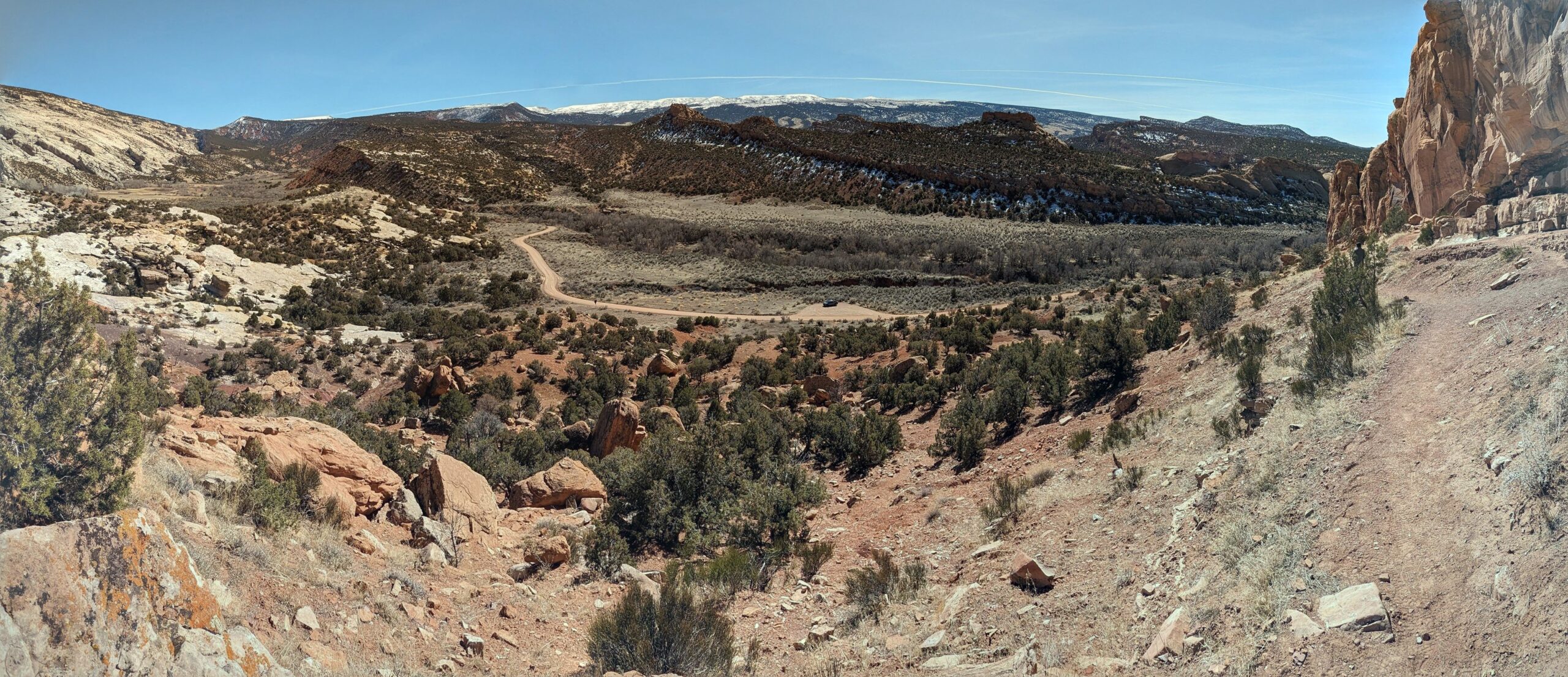History
The fossil find that saved Dinosaur National Monument from oblivion

Earl Douglass (left) and Carnegie Museum Director William J. Holland, posing with a fossil. Photo: NPS Earl Douglass Collection/edited by Evan Hall
On August 4, 1915, president Woodrow Wilson created Dinosaur National Monument. In his proclamation, he declared that the monument held 'extraordinary… Dinosaurian and reptilian remains.'
In the 1950s, Dinosaur National Monument became the center of one of the most significant preservation debates in the history of the National Park Service.
The monument, which consists of more than 210,000 acres straddling the Utah-Colorado border, protects the scenic canyons and confluence of the Green and Yampa Rivers. One of these canyons, Echo Park, was the proposed site for a dam built by the Bureau of Reclamation.
Environmental groups, such as the Sierra Club and Wilderness Society, rose up in defense of the scenery of Dinosaur National Monument, claiming that to build a dam in a national park site contradicted the philosophical and legal purpose of the National Park Service.
Though history has defined Dinosaur National Monument based on this environmental controversy, it has nothing to do with the resource the monument was created to protect—and the one for which it is named.

Scouring the Hills and Filling the Museums
In the years after the Civil War, museums in large eastern cities, like the Peabody Museum in New Haven, Connecticut and Carnegie Museum in Pittsburgh, Pennsylvania, were eager to fill their halls with fossil specimens from the newly opened American West.
Settlement and development in Western states and territories was increasing, and from them came rumors and stories of alien landscapes, ancient structures, and mysterious fossils. Taking these rumors seriously, expeditions of geologists, paleontologists, and other scientifically-trained individuals began to survey, record, and confirm the wonders of the American West.
Among these scientists was Earl Douglass, a staff paleontologist for the Carnegie Museum. In 1908, Douglass and Carnegie Museum Director William J. Holland visited the Uinta Basin of northeastern Utah in search of fossils within the Morrison Formation.
Throughout this region of Colorado and Utah, locals had begun to notice a density of fossils in this specific layer of rock. When news of this reached eastern intellectuals—like those at the Carnegie Museum—they dispatched Douglass to investigate. In 1908, he successfully discovered the femur of a Diplodocus, but it was far too heavy for him to extract himself.
The following year, Earl Douglass returned in search of more fossils. Though he scoured the hills for several weeks, he found no success. Disheartened by the lack of quality fossils, he nearly gave up.
On August 17, 1909, Douglass scrambled over an outcropping of the Morrison Formation with his eyes trained downwards. Exposed from the rock face, he finally made an almost unbelievable, incredible discovery. He later wrote, “…I saw eight of the tail bones of [an Apatosaurus] in exact position. It was a beautiful sight.”

Protecting the Dig Site
Earl Douglass discovered vertebrae connected to a partially complete skeleton that day. As the skeleton was excavated, the fossil remains of many more dinosaurs were revealed.
The discovery site, named the Carnegie Quarry, would yield 350 tons of fossils, including those of Dryosaurus, Stegosaurus, Camarasaurus, Barosaurus, Diplodocus, and Allosaurus.
The first Apatosaurus that Douglass unearthed was promptly packaged and shipped to be displayed in the Carnegie Museum of Natural History. Its patron—the great railroad tycoon Andrew Carnegie—was quite pleased.
While Douglass planned to devote the rest of his life to the Carnegie Quarry and move his family to a nearby ranch, its future was never certain. The Carnegie Museum held no legal title to the land where Douglass had made his discovery.
In a longshot, they tried to gain ownership of the land by filing a mining claim with the General Land Office, the agency responsible for enforcing laws like the 1861 Homestead Act. The mining claim was rejected because fossils were not counted as minerals.
Douglass and his colleagues began to feel anxious about the future of their discovery. Though the Carnegie Museum had been unsuccessful in its claim, perhaps some other individual would gain title to the land and end Douglass’ research.

The Protection of the “Dinosaurian” Remains
Luckily for Douglass and the Carnegie Museum, a new, powerful landscape preservation tool had been passed by Congress in the early 1900s. The 1906 Antiquities Act granted the president the power to unilaterally protect scenic, scientific, and cultural resources by executive order.
If the case could be made to the president, a landscape could be set aside and protected with the stroke of a pen. The Carnegie Quarry, with its incredible density and diversity of fossils, certainly qualified as a unique and valuable scientific resource.
On August 4, 1915, President Woodrow Wilson created Dinosaur National Monument. In his proclamation, he declared that the monument held “extraordinary… Dinosaurian and reptilian remains.” When the National Park Service was created in the summer of 1916, Dinosaur National Monument was placed under its care.
As created by Woodrow Wilson, the original monument was a miniscule 80 acres. At this size, it included none of the Echo Park canyon that would become so controversial in the 1950s.
At the recommendation of the National Park Service, Franklin D. Roosevelt expanded the monument by more than 200,000 acres in 1938 to include the confluence of the Green and Yampa rivers.
To this day, Dinosaur National Monument remains a fascinating and remote unit in the National Park System, worth the attention of any national park enthusiast.
Written by for National Park Explorer.


















